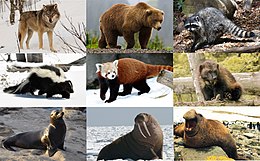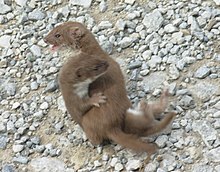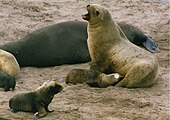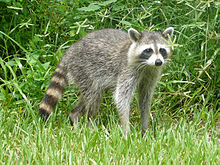Caniformia
| Caniforms | |
|---|---|

| |
| All extant caniform families(from left to right):Canidae,Ursidae,Procyonidae,Mephitidae,Ailuridae,Mustelidae,Otariidae,Odobenidae,Phocidae | |
| Scientific classification | |
| Domain: | Eukaryota |
| Kingdom: | Animalia |
| Phylum: | Chordata |
| Class: | Mammalia |
| Order: | Carnivora |
| Suborder: | Caniformia Kretzoi,1943 |
| Subgroups | |
| |
Caniformiais asuborderwithin the orderCarnivoraconsisting of "dog-like" carnivorans. They includedogs(wolves,foxes,etc.),bears,raccoons,andmustelids.[1]ThePinnipedia(seals,walrusesandsea lions) are also assigned to this group. The center of diversification for the Caniformia is North America and northernEurasia.Caniformia stands in contrast to the other suborder of Carnivora, theFeliformia( "cat-like" carnivorans), the center of diversification of which was in Africa andsouthern Asia.
Description
[edit]Most members of this group have nonretractile claws (thefisher,[2]marten,[3]sea otter(forepawsonly),[4]red panda,[5]andringtail,and somefoxeshave retractile or semi-retractile claws[6]) and tend to beplantigrade(with the exception of theCanidae). Other traits that separate the Caniformia from the Feliformia is that caniforms have longerjawsand more teeth, with less specializedcarnassial teeth.They also tend more towardsomnivoryand opportunistic feeding, while the feliforms, other than theviverrids,are more specialized for eating meat. Caniforms have single-chambered or partially dividedauditory bullae,composed of a single bone, while in feliforms, the auditory bullae are double-chambered, composed of two bones joined by aseptum.[7]In the Caniformia, thebulbourethral glandsandvesicula seminalisare always absent. Relative to body size, thebaculumis usually longer in the Caniformia than in theFeliformia.[7]
Extant families
[edit]

Caniformia consists of nine extant families, with three extinct families also recognized. The extant families aremonophyleticaccording tophylogeneticmolecular analysis.[8]Terrestrial caniforms in the wild are found on allcontinentswith the exception of Antarctica, whilepinnipedsare distributed throughout the world's oceans.
Family Canidae (dogs and othercanids) includeswolves,dogs,coyotes,andfoxes,as well as a number of less familiar animals. The family is currently divided into two major groups, the true dogs (tribe Canini), which includes nine genera, and the true foxes (tribe Vulpini) with two genera. In addition, two basal genera are described. About 35 species of extant canids are currently recognized. Canids are the most social of all caniforms, sometimes living inpacks.The dog is the most diverse of all mammals in terms of body structure variants.[citation needed]
Family Ursidae (bears) is the largest of all the land caniforms. Eight species are recognized, divided into five genera. They range from the largepolar bear(350–680 kilograms (770–1,500 lb) in males) to the smallsun bear(30–60 kilograms (66–132 lb) in males) and from the endangeredgiant pandato the very commonblack bear.Common characteristics of modern bears include a large body with stocky legs, a long snout, shaggy hair, plantigrade paws with five nonretractile claws, and a short tail. Most bears are omnivorous, with largely varied diets that include both plants and animals. The polar bear is the most carnivorous of bears due to the arctic climate in which it lives, and shows a preference for eating seals. The giant panda is the most herbivorous bear and has evolved a number of adaptations, including a sixth "toe", specialized teeth, and strong jaw muscles, to allow it to feed nearly exclusively onbamboo,a tough member of the grass family. Thesloth bearhas some adaptations forant and termite eating,with a long snout, powerful claws, and missing upper front teeth, though it also eats honey and fruit.
Family Ailuridae consists today of a single species, thered panda,which was once thought to be included in the Procyonidae or Ursidae lineages, but is now placed in its own family along with a number of extinct species. It is found in theHimalayas,including southernChina,Nepal,Bhutan,India,andPakistan.Fossil species of the family are also found inNorth America.[9]
Family Mephitidae (skunks and stink badgers) was once classified as mustelids, but are now recognized as a lineage in their own right. The 12 species of skunks are divided into fourgenera:Mephitis(hooded and striped skunks, two species),Spilogale(spotted skunks, four species),Mydaus(stink badgers, two species) andConepatus(hog-nosed skunks,four species). The two skunk species in the genusMydausinhabitIndonesiaand thePhilippines;all other skunks inhabit theAmericasfromCanadato centralSouth America.
Family Mustelidae (badgers, weasels and otters) is the largest family of carnivora, with 22 extant genera and roughly 57 extant species. While highly variable in shape, size, and behavior, most mustelids are smaller animals with short legs, short, round ears, and thick fur. Mustelids are predominantly carnivorous. While not all share identicaldentition,they all possess teeth adapted for eating flesh, including the presence of shearingcarnassials.
Members of Family Procyonidae (raccoons, coatis) are smallish animals, with generally slender bodies and long tails. Nineteen extant species in six genera are currently recognized. Except for thekinkajou,all procyonids have banded tails and distinct facial markings, and like bears, are plantigrade, walking on the soles of their feet. Most species have nonretractile claws. Early procyonids may have been an offshoot of thecanidsthat adapted to more omnivorous diets.[10]
Pinnipedia (seals, sea lions, and walruses clade) is a widely distributed and diverse group of semiaquaticmarine mammalswhich is closely related to an extinct group of pinnipeds,Enaliarctos.While support for the monophyly of pinnipeds is strong, the relationship of pinnipeds to terrestrial mammals is still unclear. Some studies support the hypothesis that the bears are their closest relatives,[11][12][13]while others support a closer relationship to the mustelids.[14][15][16][17]
Pinnipedssplitfrom other caniforms 50 million years ago (Mya) during theEocene.[16]
The clade is currently divided into three families:
- FamilyPhocidae(true or earless seals) consists of around 19 species of highly aquatic, barrel-shaped animals ranging from 45 kg (100 lb) and 1.2 m (4 ft) in length (theringed seal), to 2,400 kg (5,300 lb) and 5 m (16 ft) (southern elephant seal). Phocids are found throughout the world's oceans.
- FamilyOtariidae(eared seals,sea lions,fur seals) is distributed throughout the world's oceans with the exception of the North Atlantic. The 15 species (divided into seven genera) of otariids are distinguished from phocids by visible external ears (pinnae), more dog-like faces, and the ability to turn their rear flippers forward.
- FamilyOdobenidaecurrently includes a single species, thewalrus.A large (2,000 kg or 4,400 lb), distinctive pinniped with longwhiskersandtusks,the walrus has a discontinuous circumpolar distribution in theArctic Oceanandsub-Arcticseas of theNorthern Hemisphere.It is primarily abenthicforager ofbivalve mollusksand othermarine invertebrates.

Evolution
[edit]Caniforms first appeared as tree-climbing, superficiallymarten-like carnivores in theEocenearound 42 Mya.Miacis cognituswas probably an early caniform. Like many other early carnivorans it was well suited for tree climbing with needle-sharp claws, and had limbs and joints that resemble those of modern carnivorans.M. cognituswas probably a very agile forest dweller thatpreyedon smaller animals, such as smallmammals,reptiles,andbirds.


Debate continues on the origin of pinnipeds. Recent molecular evidence suggests pinnipeds evolved from a bear-like ancestor about 23 Mya during thelateOligoceneor earlyMioceneepochs, a transitional period between the warmerPaleogeneand coolerNeogeneperiods.[15]However, discovery of the fossilPuijila darwiniinearly Miocenedeposits inNunavutsuggests a different scenario. Like a modernotter,Puijilahad a long tail, short limbs, and webbed feet instead of flippers. However, its limbs and shoulders were more robust, andPuijilalikely had been a quadrupedal swimmer–retaining a form of aquatic locomotion that give rise to the major swimming types employed by modern pinnipeds.Puijilahas been assigned to a clade ofmustelids.
Classification
[edit]- Suborder:Caniformia( "dog-like" carnivorans)
- Genus: †Lycophocyon
- Superfamily:Amphicyonoidea
- Family: †Amphicyonidae(bear-dogs)
- Infraorder:Cynoidea
- Infraorder:Arctoidea
- Parvorder:Ursida
- Superfamily:Musteloidea
- Genus: †Plesiogale
- Family:Ailuridae(red pandaand allies)
- Family:Mephitidae(skunksandstink badgers)
- Family:Mustelidae(weaselsand allies)
- Family:Procyonidae(raccoonsand allies)
- Incertae sedis:
- Genus: †Peignictis
- Parvorder:Pinnipedimorpha
- Genus: †Pinnarctidion
- Family: †Enaliarctidae
- Family: †Semantoridae
- Division:Pinnipediformes
- Genus: †Pacificotaria
- Genus: †Pteronarctos
- Subdivision:Pinnipedia
- Superfamily:Otarioidea
- Family:Odobenidae(walrusand allies)
- Family:Otariidae(eared seals)
- Superfamily:Phocoidea
- Family:Phocidae(true seals)
- Family: †Desmatophocidae
- Superfamily:Otarioidea
Phylogeny
[edit]Thecladogramis based onmolecular phylogenyof six genes in Flynn (2005),[15]with the musteloids updated following the multigene analysis of Law et al. (2018).[18]
| Caniformia | |
References
[edit]- ^Basic Biology (2015)."Carnivora".
- ^Rhines, C (2003)."Martes pennanti".Animal Diversity Web.RetrievedMarch 12,2011.
- ^"American Marten".New York State Department of Environmental Conservation.RetrievedMarch 12,2011.
- ^Silverstein, Alvin; Silverstein, Virginia and Robert (1995). The Sea Otter. Brookfield, Connecticut: The Millbrook Press, Inc.ISBN978-1-56294-418-6.OCLC 30436543. p11.
- ^Roberts, M. S.; Gittleman, J. L. (1984)."Ailurus fulgens"(PDF).Mammalian Species(222). The American Society of Mammalogists: 3.doi:10.2307/3503840.JSTOR3503840.S2CID253993605.Archived fromthe original(PDF)on May 15, 2013.RetrievedMarch 12,2011.
- ^Goldberg, J. (2003)."Bassariscus astutus".Animal Diversity Web.RetrievedMarch 12,2011.
- ^abR. F. Ewer (1973).The Carnivores.Cornell University Press.ISBN978-0-8014-8493-3.Retrieved9 January2013.
- ^Eizirik E.; Murphy W.J.; Koepfli K.P.; Johnson W.E.; Dragoo J.W.; O'Brien S.J. (2010)."Pattern and timing of the diversification of the mammalian order Carnivora inferred from multiple nuclear gene sequences".Molecular Phylogenetics and Evolution.56(1): 49–63.doi:10.1016/j.ympev.2010.01.033.PMC7034395.PMID20138220.
- ^"Two new carnivores from an unusual late Tertiary forest biota in eastern North America"(PDF).Archived fromthe original(PDF)on 2007-09-30.Retrieved2007-02-27.
- ^Russell, James (1984). Macdonald, D. (ed.).The Encyclopedia of Mammals.New York: Facts on File. pp.98–99.ISBN0-87196-871-1.
- ^Lento, G. M.; Hickson, R. E.; Chambers, G. K.; Penny, D. (1995). "Use of spectral analysis to test hypotheses on the origin of pinnipeds".Molecular Biology and Evolution.12(1): 28–52.doi:10.1093/oxfordjournals.molbev.a040189.PMID7877495.
- ^Hunt, R. M. Jr.; Barnes, L. G. (1994)."Basicranial evidence for ursid affinity of the oldest pinnipeds".Proceedings of the San Diego Society of Natural History.29:57–67.
- ^Higdon, J. W.; Bininda-Emonds, O. R.; Beck, R. M.; Ferguson, S. H. (2007)."Phylogeny and divergence of the pinnipeds (Carnivora: Mammalia) assessed using a multigene dataset".BMC Evolutionary Biology.7:216.doi:10.1186/1471-2148-7-216.PMC2245807.PMID17996107.
- ^Sato, J. J.; Wolsan, M.; Suzuki, H.; Hosoda, T.; Yamaguchi, Y.; Hiyama, K.; Kobayashi, M.; Minami, S. (2006). "Evidence from nuclear DNA sequences sheds light on the phylogenetic relationships of Pinnipedia: Single origin with affinity to Musteloidea".Zoological Science.23(2): 125–46.doi:10.2108/zsj.23.125.hdl:2115/13508.PMID16603806.S2CID25795496.
- ^abcFlynn, J. J.; Finarelli, J. A.; Zehr, S.; Hsu, J.; Nedbal, M. A. (2005)."Molecular phylogeny of the Carnivora (Mammalia): Assessing the impact of increased sampling on resolving Enigma tic relationships".Systematic Biology.54(2): 317–37.doi:10.1080/10635150590923326.PMID16012099.
- ^abHammond, J. A.; Hauton, C.; Bennett, K. A.; Hall, A. J. (2012). Nikolaidis, Nikolas (ed.)."Phocid seal leptin: Tertiary structure and hydrophobic receptor binding site preservation during distinct leptin gene evolution".PLOS ONE.7(4): e35395.Bibcode:2012PLoSO...735395H.doi:10.1371/journal.pone.0035395.PMC3334926.PMID22536379.
- ^Rybczynski, N.; Dawson, M. R.; Tedford, R. H. (2009). "A semi-aquatic Arctic mammalian carnivore from the Miocene epoch and origin of Pinnipedia".Nature.458(7241): 1021–24.Bibcode:2009Natur.458.1021R.doi:10.1038/nature07985.PMID19396145.S2CID4371413.
- ^Law, Chris J.; Slater, Graham J.; Mehta, Rita S. (2018-01-01)."Lineage Diversity and Size Disparity in Musteloidea: Testing Patterns of Adaptive Radiation Using Molecular and Fossil-Based Methods".Systematic Biology.67(1): 127–144.doi:10.1093/sysbio/syx047.ISSN1063-5157.PMID28472434.
